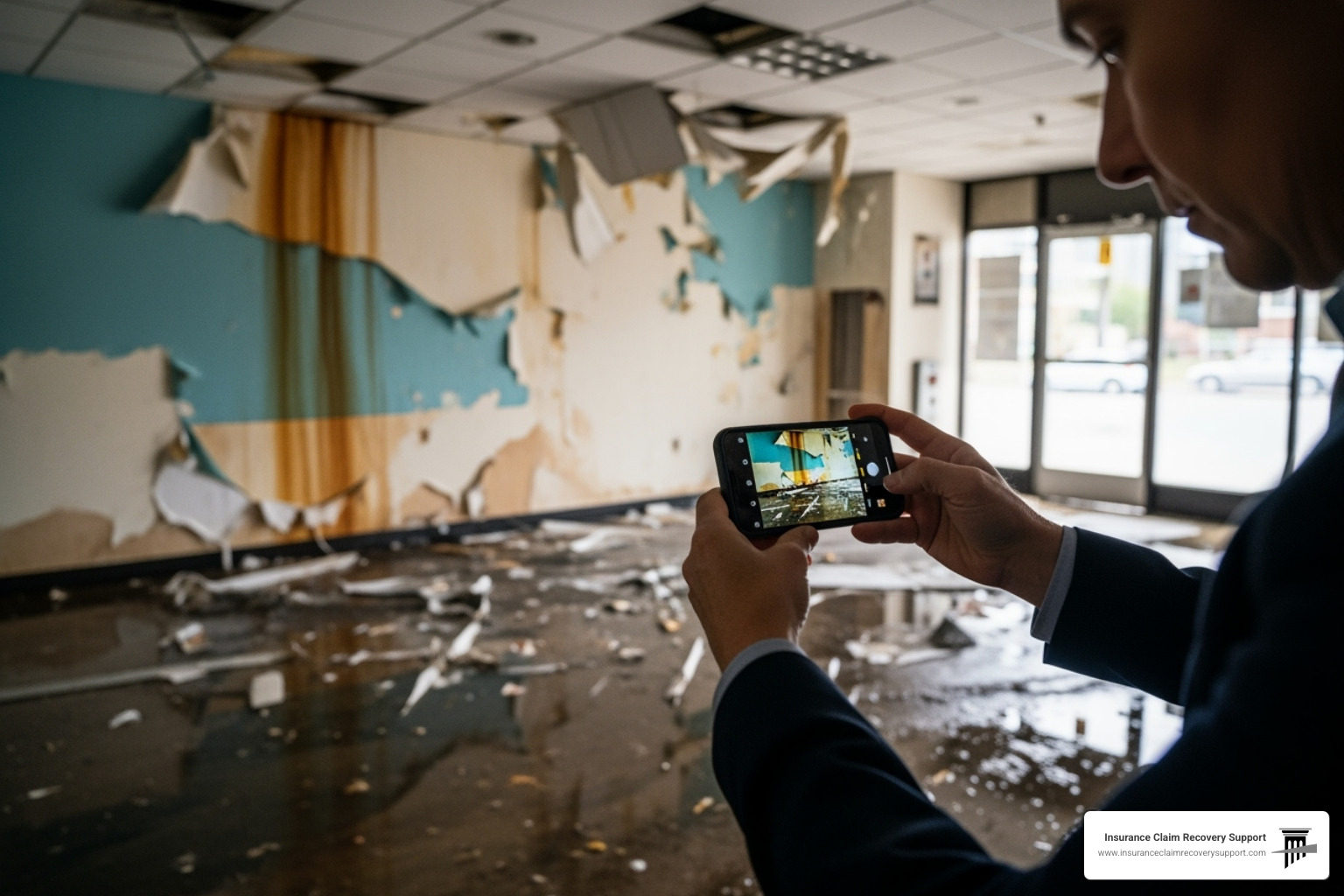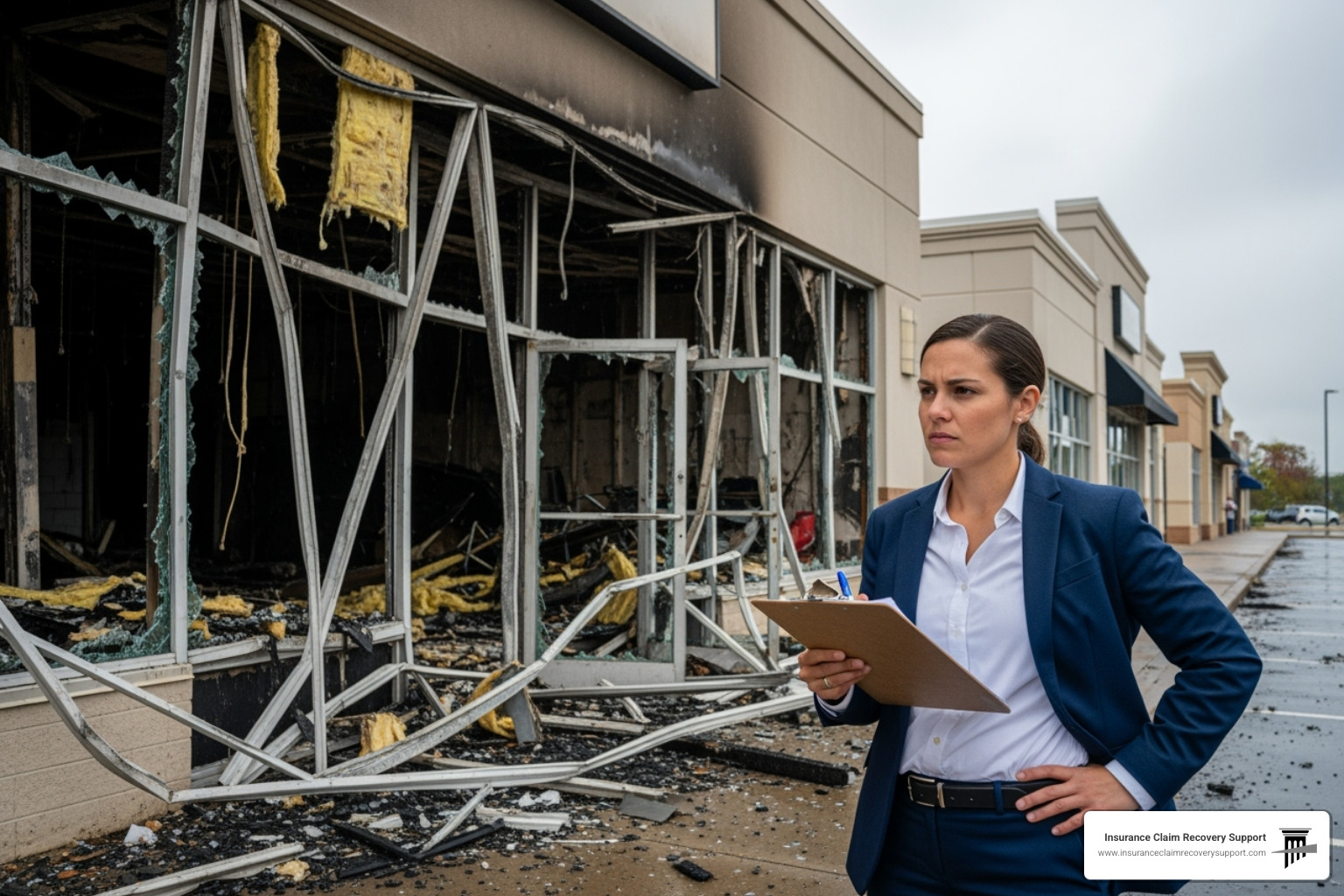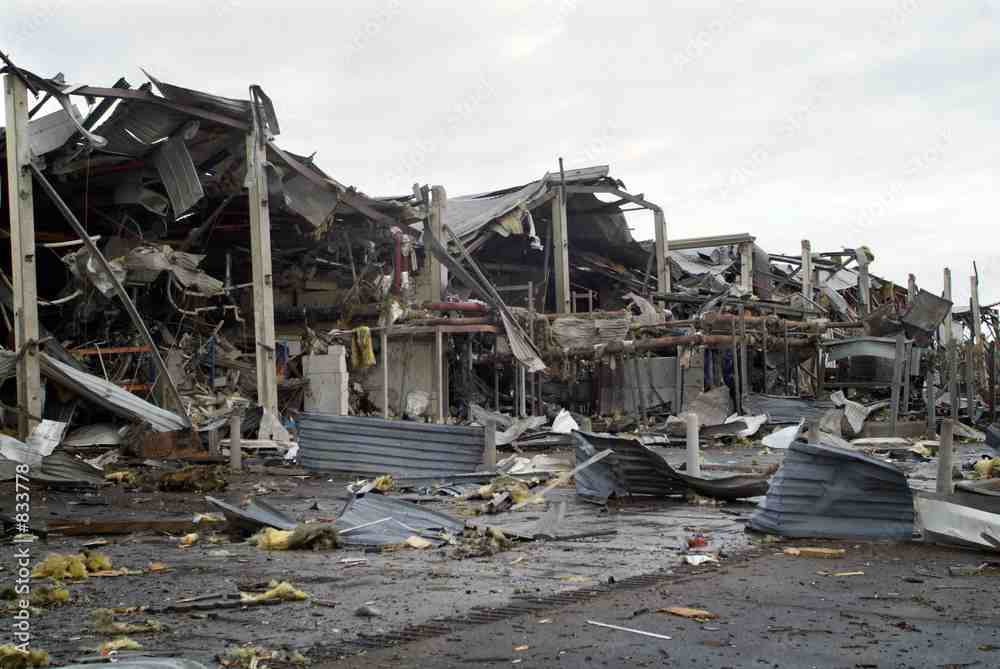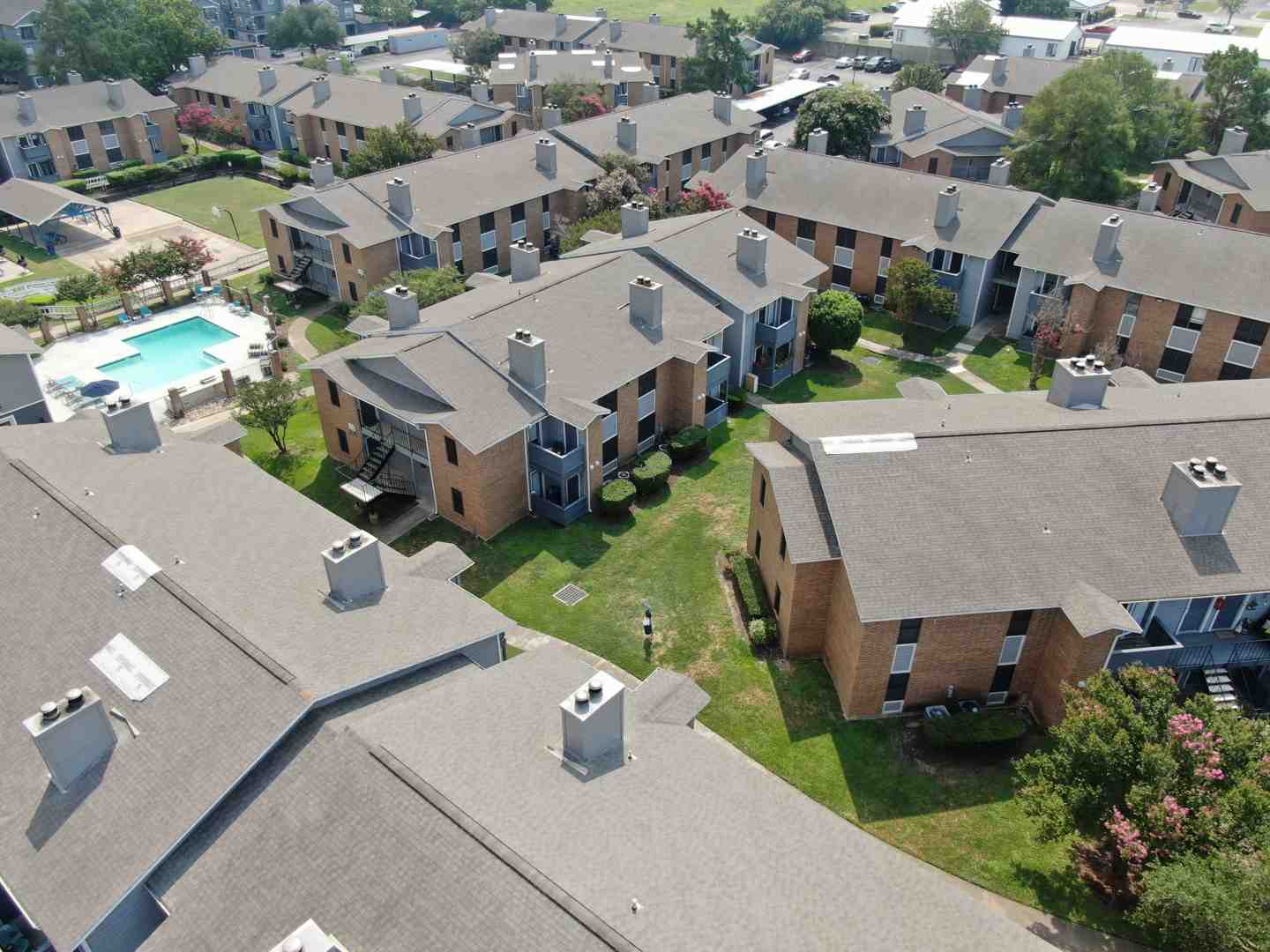Why Every Business Owner Needs to Understand Commercial Property Claims
When disaster strikes your commercial property, a business property insurance claim is your lifeline. Understanding the process is crucial for survival and recovery. Whether facing fire, storm, or water damage, navigating your claim correctly can mean the difference between a fair settlement and financial ruin.
Here’s what you need to know about business property insurance claims:
- Act immediately: Secure the property, document damage, and notify your insurer within 24-72 hours
- Understand your coverage: Know the difference between replacement cost and actual cash value policies
- Document everything: Photos, videos, receipts, and detailed inventories are essential for claim success
- File promptly: Submit your Proof of Loss form within 60 days when requested by your insurer
- Know your rights: Texas law requires insurers to acknowledge claims within 15 days and decide within 15 business days
- Consider professional help: Public adjusters can increase settlements by 30% to over 3,800% compared to initial offers
The reality is stark: business insurance claims are vital for the survival and recovery of any commercial entity facing property damage. The average commercial property claim is significant, but major events like fires or natural disasters can easily reach hundreds of thousands of dollars. Small businesses are disproportionately affected, with many struggling to recover after significant losses.
The first few hours following a loss are the most critical for responding effectively to mitigate damage and begin the recovery process. That’s why preparation and immediate action are so important.
I’m Scott Friedson, a Multi-State Licensed Public Adjuster who has successfully settled over 500 large-loss business property insurance claims valued at more than $250 million. My experience includes overturning wrongfully denied claims and helping commercial property owners secure fair settlements for fire, hail, hurricane, and other property damage events while avoiding unnecessary litigation.

Business property insurance claim basics:
Before a Loss: How to Prepare Your Business for a Property Claim
Disaster preparedness is like a seatbelt for your business: you hope you never need it, but it’s critical when trouble hits. For commercial property owners and managers, this preparation can mean a smooth recovery instead of months of financial stress.
The smartest business property insurance claim strategy begins long before any damage occurs. It involves establishing disaster plans, understanding your coverage, securing vital documents, and maintaining detailed asset inventories.
Understanding Your Commercial Property Policy
Your commercial property insurance policy is your business’s financial lifeline. Understanding its details can save you thousands when filing a business property insurance claim.
Replacement Cost Value (RCV) versus Actual Cash Value (ACV) is a critical distinction. RCV coverage pays to repair or replace property at today’s prices without depreciation. ACV coverage pays replacement cost minus depreciation. For example, if a storm damages a 10-year-old computer, an RCV policy covers a new system, while an ACV policy only pays the depreciated value.
Coverage limits set the maximum your insurer will pay. These limits must accurately reflect your property’s true value and potential losses. Underestimating these limits leaves you paying the difference out of pocket.
Deductibles are your out-of-pocket expense before coverage begins. Commercial deductibles are often a percentage of your property’s value, which can mean significant upfront costs.
Exclusions specify what your policy doesn’t cover, such as floods, earthquakes, and normal wear and tear. In Texas, windstorm coverage often requires a specific endorsement.
Endorsements modify your base policy, adding coverage for specific risks. A flood endorsement is crucial for a Houston property.
Named perils policies only cover losses explicitly listed, like fire. All-risk or Special Form policies cover everything unless specifically excluded, providing broader protection. All-risk policies generally offer better coverage but cost more.
Creating a Rock-Solid Property and Asset Inventory
After a fire in your Dallas warehouse, trying to recall every destroyed item from memory is an expensive guessing game. A current inventory is the backbone of a successful business property insurance claim, proving what you owned and its worth.
Equipment documentation should include every piece of business property, from machinery in San Antonio factories to office furniture in Fort Worth high-rises.
Purchase records like invoices and receipts provide undeniable proof of ownership and value.
Capital asset ledgers are vital for larger businesses, detailing acquisition dates, costs, and depreciation. For older items, these ledgers, appraisals, and maintenance records establish current value.
Visual documentation through regular photos and videos creates powerful evidence. Walk through your property with a camera, capturing equipment, inventory, and building features. Update these records after major purchases or renovations.
Secure storage protects your documentation. Store digital copies in cloud-based systems or off-site. When your building is damaged, you’ll still have access to the records needed for your claim.
This preparation is invaluable when you’re working to maximize your settlement and helps avoid lengthy disputes, allowing you to focus on recovery.
After the Damage: Your Immediate 7-Step Action Plan
In the first few hours after disaster strikes your commercial property, your immediate response can make or break your business property insurance claim. This is true whether you face fire in Dallas, storm damage in Houston, or water intrusion at your San Antonio religious institution.
The insurance claims process can stretch for weeks or months, which is why the first hours are so important for protecting your property and setting up a successful recovery. Our approach prioritizes immediate safety and damage mitigation, which is a requirement under most commercial property insurance policies.

Step 1: Ensure Safety and Mitigate Further Damage
After ensuring everyone’s safety, your priority is protecting the property from further harm.
If your building shows signs of structural damage, gas leaks, or exposed wiring, evacuate immediately and call emergency services. Do not risk lives.
Next, turn off your utilities as needed. Shut off the main water supply for water damage. Turn off electricity and gas for fire damage or exposed wiring.
Securing your premises is equally crucial. Board up broken windows, repair damaged doors, and create barriers to prevent theft or further weather damage. For example, after a tornado damages a Waco commercial building, tarping the roof is essential to prevent rain from causing more harm.
Keep every receipt for emergency repairs and mitigation. Your policy typically covers these necessary expenses, but you need documentation for reimbursement.
Your policy requires you to take reasonable steps to prevent further damage. However, contact your insurer before making major non-emergency repairs, as unauthorized work can complicate your claim.
Step 2: Document Everything Carefully
Thorough documentation is the foundation of a successful business property insurance claim. If it’s not documented, it’s as if it didn’t happen.
Start taking photos and videos as soon as it’s safe. Capture everything from multiple angles—wide shots for overall damage and close-ups for specific details. Ensure your device timestamps each image. If your Austin apartment complex has a pipe burst, document the initial water intrusion and all affected areas.
Write detailed notes about your observations, including dates, times, and specific descriptions of the damage. Create a comprehensive list of every lost or damaged item.
Don’t throw anything away unless it’s a safety hazard. The insurance adjuster needs to inspect damaged items. Always confirm with your insurer before disposing of anything.
Collect all receipts for temporary repairs and mitigation efforts. These expenses are often reimbursable, but you need proof of payment.
This careful record-keeping provides the solid evidence that supports your entire claim.
Step 3: Notify Your Insurance Provider Promptly
After securing the site and documenting the damage, promptly notify your insurance company.
Contact your insurance agent or broker first if possible. They know your policy and can guide you through the initial steps.
Most insurers offer 24/7 claims reporting hotlines. If a fire breaks out at your Round Rock religious institution at 2 AM, you can start the process immediately.
Have your policy number ready when you call, along with accurate details about the date, time, and cause of the damage.
Understanding claim deadlines is crucial. Most policies require notification “as soon as practicable,” while some specify 48-72 hours. For vandalism or theft, contact law enforcement first, then notify your insurer.
Prompt notification is a policy requirement that protects your right to coverage. The sooner you start the process, the sooner you can begin your business recovery.
Navigating Your Business Property Insurance Claim
After the initial response, you begin the formal business property insurance claim process. This stage is complex, but we’ve guided hundreds of property owners through it.
Most business owners have never filed a major property claim. You’re suddenly dealing with adjusters, complex forms, and industry jargon while your business is disrupted. It’s normal to feel overwhelmed.

Your insurance company’s adjuster works to settle your claim fairly but also to protect their employer’s interests. Understanding the process is crucial for protecting your financial recovery.
The Texas Prompt Payment of Claims Act (TPPCA) protects policyholders under Texas Insurance Code Chapter 542. Under this law, insurers must acknowledge your claim within 15 days, decide within 15 business days after receiving all information, and if approved, pay within five business days. These are legal requirements.
Initiating the Formal Business Property Insurance Claim Process
After your initial call, your insurer opens a claim file and gives you a claim number for all future communications.
Filing the claim is more than one phone call. Your insurer will send a claims packet with forms and instructions. In Texas, they must acknowledge your claim within 15 days.
Your collected required documentation (photos, videos, inventories, receipts) is the foundation of your claim. The adjuster reviews this to determine coverage and compensation.
The Proof of Loss form is a critical sworn statement listing every damaged item and its value. You typically have 60 days from your insurer’s request to return it. Accuracy is vital; false statements can void your policy.
Working with the company adjuster requires balance. Be present during their inspection to point out all damage, ask questions, and take notes.
Communication records are your lifeline in a dispute. Log every call, email, and meeting, noting the date, person, and discussion. This paper trail is invaluable.
Understanding Business Interruption and Extra Expense Claims
When property damage closes your business, the financial impact goes beyond repairs. Business interruption insurance is a financial lifesaver for lost income.
Lost income calculation determines what your business would have earned during the disruption. For a Dallas apartment complex, this is lost rent; for a Houston restaurant, it’s lost revenue. Insurers analyze past financial records, including seasonal trends and growth, to project lost income. This complexity often requires forensic accounting expertise.
Continuing operating expenses like mortgages, salaries, and insurance premiums don’t stop. Business interruption coverage helps pay these costs during your period of restoration—the time it takes to repair and resume operations.
Civil authority coverage applies when government actions block access to your property, even without direct damage. For example, when a tornado hit Round Rock, cordoned-off businesses could claim lost income under this coverage, which typically starts 72 hours after the action.
Relocation costs and other extra expenses for operating from a temporary location are often covered. If your Austin office needs repairs, renting temporary space and moving equipment are covered extra expenses.
Business interruption claims are complex because lost income involves projections, not just physical damage. This is why forensic accounting is often necessary to substantiate these claims fully.
Handling a Complex Business Property Insurance Claim
Some losses are straightforward, but others involve multiple damage types and extensive losses, making the business property insurance claim process far more complex.
Fire damage is challenging. Beyond the visible flames, smoke infiltrates every corner, soot contaminates HVAC systems, and water from firefighting efforts causes secondary damage. These hidden costs can significantly increase the claim’s value.
Water and flood damage requires knowing the difference between covered and excluded perils. A burst pipe in a Houston apartment complex is typically covered; rising floodwaters are not without separate flood insurance. Quick action can prevent mold, but always document damage before cleanup.
Hurricane and wind damage can cause structural issues that aren’t immediately visible. Compromised roof membranes or wind-driven rain can lead to mold weeks later.
Theft and vandalism claims start with a police report for third-party verification. The insurance claim requires more, including serial numbers and proof of ownership for stolen items.
Texas-specific perils like tornadoes can overwhelm insurers when they affect large areas, leading to delays. These situations often require expert advocacy to ensure your claim gets proper attention.
The common thread in all complex claims is the need for meticulous documentation and expert guidance.
Securing a Fair Settlement: Overcoming Delays and Disputes
Filing a business property insurance claim doesn’t guarantee a smooth recovery. Even with perfect preparation, you may face delays, lowball offers, or denials that threaten your business. Common issues include slow adjuster assignments, excessive documentation requests, and depreciation disputes.
But you have rights as a policyholder and don’t have to accept an unfair settlement. In Texas, the Texas Prompt Payment of Claims Act sets legal deadlines for insurers. When they fail to comply, there are consequences.
| Approach | Public Adjuster | Insurance Claim Lawsuit |
|---|---|---|
| Timeline | 30-120 days typical | 1-3 years average |
| Cost | Percentage of settlement (no upfront fees) | Hourly attorney fees plus court costs |
| Your Involvement | Minimal – we handle everything | Extensive depositions, court appearances |
| Success Rate | 95%+ settlement rate | 60-70% win rate at trial |
| Stress Level | Low – professional advocacy | High – adversarial process |
| Business Focus | You can focus on operations | Significant time away from business |
Why Commercial Claims Differ from Homeowners’ Claims
Business property insurance claims are in a different league than homeowner claims. The scale of loss is much larger, often reaching millions for a Houston apartment complex or Fort Worth religious institution. The required documentation is far more extensive, and the business interruption component adds layers of complexity, like calculating lost income, that don’t exist in residential claims.
Policy complexity is another major difference. Commercial policies like a Business Owners Policy (BOP) or a Commercial Package Policy (CPP) have custom provisions. Valuing specialized manufacturing or restaurant equipment also requires industry expertise, unlike valuing typical household items.
How a Public Adjuster Can Help Maximize Your Claim
When your business property insurance claim hits roadblocks, you need an advocate who speaks the insurer’s language and fights for your interests. That’s where a public adjuster comes in.
We challenge lowball settlement offers. An insurer might offer $200,000 for fire damage to an Austin office building, but our thorough assessment could reveal the true cost is $750,000. We build a compelling case for the full amount you deserve.
We identify hidden damage often missed by company adjusters. For a San Antonio multifamily complex with water damage, we bring in experts to uncover the full extent of your losses, including potential foundation issues or mold.
We manage the entire claim process, freeing you to run your business. Our clients often tell us the peace of mind alone is worth our fee.
Sometimes insurers delay, deny claims without cause, or use other bad faith tactics. We recognize these red flags and know how to challenge them. The Texas Insurance Code provides strong protections against unfair claim settlement practices, and we use these tools to protect your rights.
Our track record of settling over 500 large-loss claims valued at over $250 million speaks for itself. Studies show public adjusters significantly increase payouts—sometimes by over 3,800%—representing businesses that recovered fully instead of struggling.
We help you avoid unnecessary litigation. While lawsuits are sometimes necessary, they are expensive and time-consuming. We offer a powerful alternative. By thoroughly documenting your claim and expertly negotiating, we frequently secure fair settlements without legal action. This approach saves you time, money, and stress, allowing you to focus on rebuilding. Our process builds a path toward resolution that typically concludes within months, not years.







